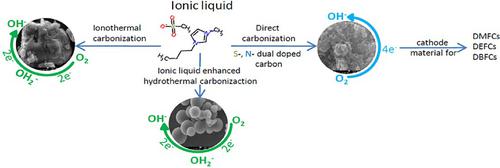当前位置:
X-MOL 学术
›
ChemElectroChem
›
论文详情
Our official English website, www.x-mol.net, welcomes your feedback! (Note: you will need to create a separate account there.)
Electrocatalytic Activity of Ionic‐Liquid‐Derived Porous Carbon Materials for the Oxygen Reduction Reaction
ChemElectroChem ( IF 4 ) Pub Date : 2018-02-07 , DOI: 10.1002/celc.201701369 Nikola Zdolšek 1 , Aleksandra Dimitrijević 1 , Magdalena Bendová 2 , Jugoslav Krstić 3 , Raquel P. Rocha 4 , José L. Figueiredo 4 , Danica Bajuk-Bogdanović 5 , Tatjana Trtić-Petrović 1 , Biljana Šljukić 5
ChemElectroChem ( IF 4 ) Pub Date : 2018-02-07 , DOI: 10.1002/celc.201701369 Nikola Zdolšek 1 , Aleksandra Dimitrijević 1 , Magdalena Bendová 2 , Jugoslav Krstić 3 , Raquel P. Rocha 4 , José L. Figueiredo 4 , Danica Bajuk-Bogdanović 5 , Tatjana Trtić-Petrović 1 , Biljana Šljukić 5
Affiliation

|
Carbon materials, prepared by using different methods with ionic liquids, are compared as electrocatalysts for the oxygen reduction reaction (ORR). Materials were synthesized through the hydrothermal carbonization of glucose and by using the same method in the presence of 1‐butyl‐3‐methylimidazolium methanesulfonate [bmim][MeSO3] as an additive. Another two carbon‐based materials were prepared by using ionic‐liquid‐based methods: ionothermal carbonization of glucose using [bmim][MeSO3] as a recyclable medium for the carbonization reaction and by direct carbonization of the ionic liquid in a one‐step method using [bmim][MeSO3] as the precursor for N‐ and S‐doped porous carbon (Carb‐IL). Characterization results showed the possibility of morphology and porosity control by using [bmim][MeSO3]. All materials were subsequently tested for the ORR in alkaline media. Carb‐IL showed enhanced and stable electrocatalytic ORR activity, even in the presence of methanol, ethanol, and borohydride, opening the possibility for its application in fuel cells.
中文翻译:

离子液体衍生的多孔碳材料对氧还原反应的电催化活性
将通过使用不同方法与离子液体制备的碳材料作为氧还原反应(ORR)的电催化剂进行了比较。通过葡萄糖的水热碳化和在甲磺酸1-丁基-3-甲基咪唑鎓[bmim] [MeSO 3 ]的存在下使用相同的方法合成材料。通过使用基于离子液体的方法制备了另外两种基于碳的材料:使用[bmim] [MeSO 3 ]作为碳化反应的可循环介质,对离子进行离子热碳化,以及一步一步将离子液体直接碳化。 [bmim] [MeSO 3]作为N和S掺杂多孔碳(Carb-IL)的前体。表征结果表明,使用[bmim] [MeSO 3 ]可以控制形貌和孔隙率。随后在碱性介质中测试所有材料的ORR。即使在甲醇,乙醇和硼氢化物存在的情况下,Carb-IL仍显示出增强且稳定的电催化ORR活性,这为将其应用于燃料电池打开了可能性。
更新日期:2018-02-07
中文翻译:

离子液体衍生的多孔碳材料对氧还原反应的电催化活性
将通过使用不同方法与离子液体制备的碳材料作为氧还原反应(ORR)的电催化剂进行了比较。通过葡萄糖的水热碳化和在甲磺酸1-丁基-3-甲基咪唑鎓[bmim] [MeSO 3 ]的存在下使用相同的方法合成材料。通过使用基于离子液体的方法制备了另外两种基于碳的材料:使用[bmim] [MeSO 3 ]作为碳化反应的可循环介质,对离子进行离子热碳化,以及一步一步将离子液体直接碳化。 [bmim] [MeSO 3]作为N和S掺杂多孔碳(Carb-IL)的前体。表征结果表明,使用[bmim] [MeSO 3 ]可以控制形貌和孔隙率。随后在碱性介质中测试所有材料的ORR。即使在甲醇,乙醇和硼氢化物存在的情况下,Carb-IL仍显示出增强且稳定的电催化ORR活性,这为将其应用于燃料电池打开了可能性。



























 京公网安备 11010802027423号
京公网安备 11010802027423号